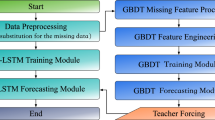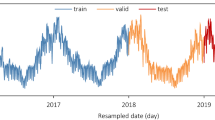Abstract
To achieve effective intraday dispatch of photovoltaic (PV) power generation systems, a reliable ultra-short-term power generation forecasting model is required. Based on a gradient boosting strategy and a dendritic network, this paper proposes a novel ensemble prediction model, named gradient boosting dendritic network (GBDD) model which can reduce the forecast error by learning the relationship between forecast residuals and meteorological factors during the training of sub-models by means of a greedy function approximation. Unlike other machine learning models, the GBDD proposed is able to make fuller use of all meteorological factor data and has a good model interpretation. In addition, based on the structure of GBDD, this paper proposes a strategy that can improve the prediction performance of other types of prediction models. The GBDD is trained by analyzing the relationship between prediction errors and meteorological factors for compensating the prediction results of other prediction models. The experimental results show that the GBDD proposed has the benefit of achieving a higher PV power prediction accuracy for PV power generation and can be used to improve the prediction performance of other prediction models.
Similar content being viewed by others
References
Govindarajan R K, Parthasarathy P R, Ganesan S I. A control scheme with performance prediction for a PV fed water pumping system. Frontiers in Energy, 2014, 8(4): 480–489
International Energy Agency. World energy outlook. 2021-10, available at website of IEA
Sobri S, Koohi-Kamali S, Rahim N A. Solar photovoltaic generation forecasting methods: A review. Energy Conversion and Management, 2018, 156: 459–497
Singla P, Duhan M, Saroha S. A comprehensive review and analysis of solar forecasting techniques. Frontiers in Energy, 2022, 16(2): 187–223
Sánchez de la Nieta A A, Paterakis N G, Gibescu M. Participation of photovoltaic power producers in short-term electricity markets based on rescheduling and risk-hedging mapping. Applied Energy, 2020, 266: 114741
Vafaei S, Rezvani A, Gandomkar M, et al. Enhancement of grid-connected photovoltaic system using ANFIS-GA under different circumstances. Frontiers in Energy, 2015, 9(3): 322–334
Yang D, Wang W, Gueymard C, et al. A review of solar forecasting, its dependence on atmospheric sciences and implications for grid integration: Towards carbon neutrality. Renewable & Sustainable Energy Reviews, 2022, 161: 112348
Ahadi A, Hayati H, Miryousefi Aval S M. Reliability evaluation of future photovoltaic systems with smart operation strategy. Frontiers in Energy, 2016, 10(2): 125–135
Tang Y, Yang K, Zhang S, et al. Photovoltaic power forecasting: A hybrid deep learning model incorporating transfer learning strategy. Renewable & Sustainable Energy Reviews, 2022, 162: 112473
Dvorak A J, Victoria M. Key determinants of solar share in solarand wind-driven grids. IEEE Journal of Photovoltaics, 2023, 13(3): 476–483
Kumler A, Xie Y, Zhang Y. A physics-based smart persistence model for intra-hour forecasting of solar radiation (PSPI) using GHI measurements and a cloud retrieval technique. Solar Energy, 2019, 177: 494–500
Dall’Anese E, Dhople S V, Johnson B B, et al. Optimal dispatch of residential photovoltaic inverters under forecasting uncertainties. IEEE Journal of Photovoltaics, 2015, 5(1): 350–359
Ferbar Tratar L, Strmčnik E. The comparison of holt-winters method and multiple regression method: A case study. Energy, 2016, 109: 266–276
Chu Y, Urquhart B, Gohari S M I, et al. Short-term reforecasting of power output from a 48 MWe solar PV plant. Solar Energy, 2015, 112: 68–77
Karimi A M, Fada J S, Parrilla N, et al. Generalized and mechanistic PV module performance prediction from computer vision and machine learning on electroluminescence images. IEEE Journal of Photovoltaics, 2020, 10(3): 878–887
Wang H, Yi H, Peng J, et al. Deterministic and probabilistic forecasting of photovoltaic power based on deep convolutional neural network. Energy Conversion and Management, 2017, 153: 409–422
Giaffreda D, Magnone P, Meneghini M, et al. Local shunting in multicrystalline silicon solar cells: Distributed electrical simulations and experiments. IEEE Journal of Photovoltaics, 2014, 4(1): 40–47
Liu J, Fang W, Zhang X, et al. An improved photovoltaic power forecasting model with the assistance of aerosol index data. IEEE Transactions on Sustainable Energy, 2015, 6(2): 434–442
Jang H S, Bae K Y, Park H S, et al. Solar power prediction based on satellite images and support vector machine. IEEE Transactions on Sustainable Energy, 2016, 7(3): 1255–1263
Khan I, Zhu H, Yao J, et al. Photovoltaic power forecasting based on Elman neural network software engineering method. In: 2017 8th IEEE International Conference on Software Engineering and Service Science. Beijing: IEEE, 2017, 747–750
Ma X, Zhang X. A short-term prediction model to forecast power of photovoltaic based on MFA-Elman. Energy Reports, 2022, 8: 495–507
Yadav A K, Sharma V, Malik H, et al. Daily array yield prediction of grid-interactive photovoltaic plant using relief attribute evaluator based radial basis function neural network. Renewable & Sustainable Energy Reviews, 2018, 81: 2115–2127
Al-Dahidi S, Ayadi O, Adeeb J, et al. Extreme learning machines for solar photovoltaic power predictions. Energies, 2018, 11(10): 2725
Hossain M, Mekhilef S, Danesh M, et al. Application of extreme learning machine for short term output power forecasting of three grid-connected PV systems. Journal of Cleaner Production, 2017, 167: 395–405
Gundu V, Simon S P. Short term solar power and temperature forecast using recurrent neural networks. Neural Processing Letters, 2021, 53(6): 4407–4418
Huang C J, Kuo P H. Multiple-input deep convolutional neural network model for short-term photovoltaic power forecasting. IEEE Access: Practical Innovations, Open Solutions, 2019, 7: 74822–74834
Hu Y, Gunapati V Y, Zhao P, et al. A nonrelational data warehouse for the analysis of field and laboratory data from multiple heterogeneous photovoltaic test sites. IEEE Journal of Photovoltaics, 2017, 7(1): 230–236
Zhou Y, Zhou N, Gong L, et al. Prediction of photovoltaic power output based on similar day analysis, genetic algorithm and extreme learning machine. Energy, 2020, 204: 117894
Ma Y, Lv Q, Zhang R, et al. Short-term photovoltaic power forecasting method based on irradiance correction and error forecasting. Energy Reports, 2021, 7: 5495–5509
Lin G Q, Li L L, Tseng M L, et al. An improved moth-flame optimization algorithm for support vector machine prediction of photovoltaic power generation. Journal of Cleaner Production, 2020, 253: 119966
Pan M, Li C, Gao R, et al. Photovoltaic power forecasting based on a support vector machine with improved ant colony optimization. Journal of Cleaner Production, 2020, 277: 123948
Zhang T, Lv C, Ma F, et al. A photovoltaic power forecasting model based on dendritic neuron networks with the aid of wavelet transform. Neurocomputing, 2020, 397: 438–446
Li P, Zhou K, Lu X, et al. A hybrid deep learning model for short-term PV power forecasting. Applied Energy, 2020, 259: 114216
Behera M K, Nayak N. A comparative study on short-term PV power forecasting using decomposition based optimized extreme learning machine algorithm. Engineering Science and Technology, 2020, 23(1): 156–167
Zhou C, Chung H, Wang X, et al. Design of CdZnTe and crystalline silicon tandem junction solar cells. IEEE Journal of Photovoltaics, 2016, 6(1): 301–308
Li Q, Zhang X, Ma T, et al. A multi-step ahead photovoltaic power prediction model based on similar day, enhanced colliding bodies optimization, variational mode decomposition, and deep extreme learning machine. Energy, 2021, 224: 120094
Zhang J, Tan Z, Wei Y. An adaptive hybrid model for day-ahead photovoltaic output power prediction. Journal of Cleaner Production, 2020, 244: 118858
Wu Y K, Chen C R, Abdul Rahman H. A novel hybrid model for short-term forecasting in PV power generation. International Journal of Photoenergy, 2014, 2014: 1–9
de Jesus D A R, Mandal P, Velez-Reyes M, et al. Data fusion based hybrid deep neural network method for solar PV power forecasting. In: 2019 North American Power Symposium. Wichita: IEEE, 1–6
Persson C, Bacher P, Shiga T, et al. Multi-site solar power forecasting using gradient boosted regression trees. Solar Energy, 2017, 150: 423–436
Wang J, Li P, Ran R, et al. A short-term photovoltaic power prediction model based on the gradient boost decision tree. Applied Sciences, 2018, 8(5): 689
Chen X, Liu Y, Li Q, et al. Short-term photovoltaic power prediction based on LGBM-XGBoost. In: 2022 5th Asia Conference on Energy and Electrical Engineering, 2022, 12–17
Lu T, Wang C, Cao Y, et al. Photovoltaic power prediction under insufficient historical data based on dendrite network and coupled information analysis. Energy Reports, 2023, 9: 1490–1500
Friedman J H. Greedy function approximation: A gradient boosting machine. Annals of Statistics, 2001, 29(5): 1189–1232
Liu G, Wang J. Dendrite net: A white-box module for classification, regression, and system identification. IEEE Transactions on Cybernetics, 2021, 52(12): 1–14
Acknowledgements
This work was supported by the National Natural Science Foundation of China (Grant Nos. 61973322 and 62103443) and the Natural Science Foundation of Hunan Province, China (Grant No. 2022JJ40630).
Author information
Authors and Affiliations
Corresponding author
Ethics declarations
Competing Interests The authors declare that they have no competing interests.
Rights and permissions
About this article
Cite this article
Wang, C., Li, M., Cao, Y. et al. Gradient boosting dendritic network for ultra-short-term PV power prediction. Front. Energy (2024). https://doi.org/10.1007/s11708-024-0915-y
Received:
Accepted:
Published:
DOI: https://doi.org/10.1007/s11708-024-0915-y




